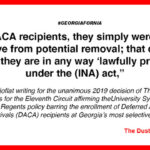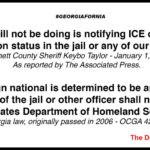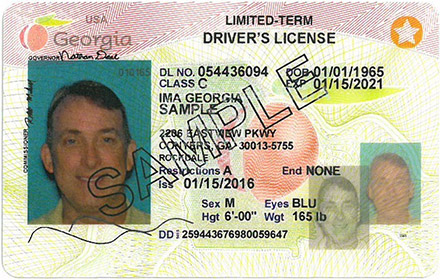From the Center for Immigration Studies in Washington D.C.
Time to pull the sanctuary jurisdiction fig leaf

Of late, I have written a number of posts about sanctuary policies issued by jurisdictions that deny that they are sanctuaries. Part of their shtick is to assert that they would comply with detainer requests that are accompanied by “judicial warrants”. Of course in the immigration context, there is no such thing.
In this blog, I borrow freely from my colleague Dan Cadman, who wrote about a similar issue in July 2018. The points that Cadman made remain relevant, and bear repeating.
But first, the contentions. One of the sanctuary policies (and probably one of the worst ones I’ve ever heard of) comes out of Montgomery County, Md. It includes the following: “Immigration detainers, that are not accompanied by judicial warrants, are civil detainers for which the federal government bears sole responsibility.” I have no idea why the extra commas were included in that sentence, nor what exactly “sole responsibility” consists of. Immigration detainers are, however, civil detainers, because immigration proceedings are civil — as opposed to criminal — in nature. Immigration detention is, however, detention, and the authority for such detention has been recognized as valid since the 19th Century.
No agent or department may arrest or detain a person based on an Administrative Warrant, an Immigration Detainer, or any other directive by DHS, on a belief that the person is not present legally in the United States or has committed a civil immigration violation.
As set forth below, detainers are not issued “on a belief that the person is not present legally in the United States or has committed a civil immigration violation”, but rather upon probable cause of those facts. That is simply an aside, however.
Not to be outdone by his neighbor to the south, on July 24, 2019, Baltimore County, Md., Executive John “Johnny O” Olszewski, Jr. (D) affirmed that an executive order captioned “Upholding Law Enforcement Standards on Immigration Status, Diversity and Equity”, issued by one of his predecessors, the late Kevin Kamenetz, remains in effect countywide. Paragraph 4 of that order states:
No personnel within the Police Department or Department of Corrections shall cause to be detained any individual beyond their court ordered release date, except upon reasonable belief of the existence of an order of detainer issued by a properly recognized judicial official. [Emphasis added.]
I have no idea what a “properly recognized judicial official” means in this context. As an immigration judge, I was properly recognized as a judicial official by the circuit courts, but it likely is intended to refer to a federal district court judge or federal magistrate.
Detainers are governed by 8 C.F.R. §287.7(a), which states:
Detainers in general. Detainers are issued pursuant to sections 236 and 287 of the [Immigration and Nationality] Act [INA] and this chapter 1. Any authorized immigration officer may at any time issue a Form I-247, Immigration Detainer-Notice of Action, to any other Federal, State, or local law enforcement agency. A detainer serves to advise another law enforcement agency that the Department seeks custody of an alien presently in the custody of that agency, for the purpose of arresting and removing the alien. The detainer is a request that such agency advise the Department, prior to release of the alien, in order for the Department to arrange to assume custody, in situations when gaining immediate physical custody is either impracticable or impossible. [Emphasis added.]
Also pertinent is 8 C.F.R. §287.7(d):
Temporary detention at Department request. Upon a determination by the Department [of Homeland Security (DHS)] to issue a detainer for an alien not otherwise detained by a criminal justice agency, such agency shall maintain custody of the alien for a period not to exceed 48 hours, excluding Saturdays, Sundays, and holidays in order to permit assumption of custody by the Department.
Section 236(a) of the INA (discussed further below) provides for the arrest and detention “[o]n a warrant issued by the Attorney General [AG]” of an alien pending a determination of whether that alien should be removed from the United States. Section 287(d) of the INAstates:
Detainer of aliens for violation of controlled substances laws
In the case of an alien who is arrested by a Federal, State, or local law enforcement official for a violation of any law relating to controlled substances, if the official (or another official)-
(1) has reason to believe that the alien may not have been lawfully admitted to the United States or otherwise is not lawfully present in the United States,
(2) expeditiously informs an appropriate officer or employee of the Service authorized and designated by the Attorney General of the arrest and of facts concerning the status of the alien, and
(3) requests the Service to determine promptly whether or not to issue a detainer to detain the alien,
the officer or employee of the Service shall promptly determine whether or not to issue such a detainer. If such a detainer is issued and the alien is not otherwise detained by Federal, State, or local officials, the Attorney General shall effectively and expeditiously take custody of the alien.
As the foregoing demonstrates, section 236 of the INA is more general, while section 287 of the INA is more circumscribed and intended for the specific benefit of other federal agencies, states, and localities. Neither of those provisions provides for, or more importantly requires, a “judicial warrant”, however.
In fact, section 236 of the INA specifically references a warrant issued by the AG, now the Secretary of Homeland Security. The regulations specifically stipulate who may issue such a detainer:
(1) Border patrol agents, including aircraft pilots;
(2) Special agents;
(3) Deportation officers;
(4) Immigration inspectors;
(5) Adjudications officers;
(6) Immigration enforcement agents;
(7) Supervisory and managerial personnel who are responsible for supervising the activities of those officers listed in this paragraph; and
(8) Immigration officers who need the authority to issue detainers under section 287(d)(3) of the [INA] in order to effectively accomplish their individual missions and who are designated individually or as a class, by the Commissioner of CBP, the Assistant Secretary for ICE, or the Director of the USCIS.
Again, there is no regulatory provision for a federal judge to issue a detainer, let alone a warrant.
Notably, the new detainer form (I-247A) specifically states “DHS HAS DETERMINED THAT PROBABLE CAUSE EXISTS THAT THE SUBJECT IS A REMOVABLE ALIEN,” and is signed by the appropriate immigration officer. Not a “belief” — probable cause.
A review of the foregoing provisions indicates that, with the specific exception in section 287(d) of the INA, neither explicitly authorizes detainers (nor do they prohibit them) but the regulations plainly do authorize the issuance of detainers. As Cadman has noted, however, detainers “are — and have been for generations — a standard protocol for asking cooperation from law enforcement agencies when seeking to take custody of aliens.” He continues:
What’s more, the filing of detainers, colloquially known as “holds”, is a standard practice throughout U.S. law enforcement at every level. Virtually all agencies seek such assistance from one another, knowing that if the system of cooperation breaks down, then all public safety is compromised.
Could you imagine how difficult it (and dangerous) it would be if, say, the FBI had to get a judicial warrant in order to put a hold on a suspected terrorist in state or local custody?
Cadman’s post specifically related to an order that was issued by Judge Michael Baylson of the U.S. District Court for the Eastern District of Pennsylvania in City of Philadelphia v. Sessions, which had to do with the provision of funding to states and localities that did not comply with certain conditions related to immigration enforcement imposed by the U.S. Department of Justice (DOJ) under the federal Edward Byrne Memorial Justice Assistance Grant Program (“Byrne JAG”).
Judge Baylson issued a memorandum adding to his final judgment (holding that DOJ could not condition those grants) to provide for the following:
To the extent an agency of the United States Government has probable cause to assert that an individual in the custody of the City of Philadelphia is a criminal alien (as previously defined by this Court in City of Philadelphia v. Sessions, 2018 WL 2725503, *n. 3, (E.D. Pa. June 6, 2018)), and seeks transfer to federal custody of such individual within a city facility, it shall secure an order from a judicial officer of the United States for further detention, as allowed by law.
He did not include a mechanism to “secure an order from a judicial officer of the United States” in that memorandum and, as noted, none is apparent. Or, as Cadman noted:
Exactly what kind of “court order” are ICE agents to seek when asking authority to detain an alien? There is no provision in the INA — no provision whatsoever — for judicial orders. Nor do they exist in any other federal statute. What the INA does specifically provide for is arrest of aliens, with or without warrant, for violations of the immigration laws — but the warrants authorized by Congress are not judicial warrants, and deliberately so.
He specifically referenced sections 236(a) and (c) of the INA, which state:
(a) Arrest, Detention, and Release.
-On a warrant issued by the Attorney General, an alien may be arrested and detained pending a decision on whether the alien is to be removed from the United States.
…
(c) Detention of criminal aliens.-
(1) Custody. The Attorney General shall take into custody any alien who [is inadmissible or deportable for criminal offenses defined under several sections of the INA] when the alien is released, without regard to whether the alien is released on parole, supervised release, or probation, and without regard to whether the alien may be arrested or imprisoned again for the same offense. [Emphasis added.]
Cadman continued:
There is absolutely no reference in any of the above citations for a need to present …please read the rest here from CIS.




































You must be logged in to post a comment.